You’re almost through the first loop of your endurance ride, and the hold is coming into view. It represents an opportunity for your horse to rest – but you, as the rider, have a lot to do! Here’s a rundown of how to handle the hold, from pulsing down to preparing for the next loop.
Did you catch the earlier posts in this series?
Part 1: Step-By-Step Guide: Before Leaving Home
Part 2: Step-By-Step Guide: Arriving in Ride Camp
Approaching the Hold
The key to a successful hold is to know what you want to see in your horse when you get there:
- Low heart rate
- Robust gut sounds
- Good hydration
- Soundness
- Bright attitude
Bearing these goals in mind while you’re out on the loop will set you up to achieve them by managing your horse well. The closer you get to the hold, the more you want to focus on your horse’s recovery.
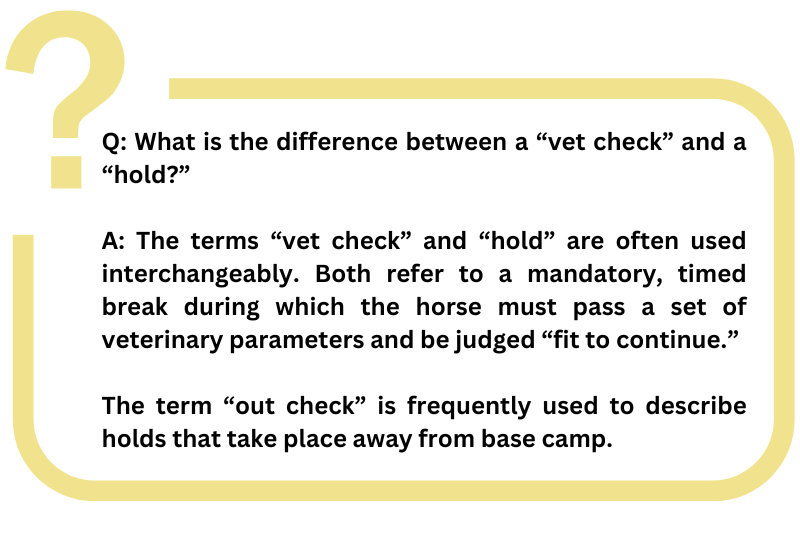
A couple miles out, you’ll often have the opportunity to offer your horse water. Encourage him to drink, and sponge water on his neck to cool him if he’s hot. If you’re electrolyting as you go, a small dose here (only if he drank) will encourage additional drinking while you’re in the hold.
If there’s grass around, let him eat a few bites. Then, continue toward the check at a moderate pace, grabbing grass here and there if you can. The idea is to get those guts moving. It can also help switch your horse’s focus from go mode to recovery mode.
When you get within a quarter mile or so of the check, dismount. Loosen your cinch and lead your horse in at a walk.
In/Out Timers
As you approach, you’ll see volunteers seated at a table with some paperwork and a clock. These are the timers. They’ll need you to call out your rider number. (You have it memorized, right?)
This is a good time to take your ride card out of its zip-top bag and unfold it in preparation to hand it to a volunteer.
The volunteers at the timing table will note your “in time,” which is when you arrived in the hold. This starts the clock on your deadline for pulsing down to the established heart rate criteria. Criteria will have been announced at the pre-ride meeting, and is typically 60-64 beats per minute. If your horse isn’t “down” within 30 minutes, you’ll be pulled.
Once the timers have your number, you can shift your attention to P&R.
Pulse (and Respiration)
The Pulse and Respiration (P&R) area is adjacent to the timing table. Pulsers – volunteers with stethoscopes and watches – will be checking horses’ heart rates and communicating with the timers about which horses are down.
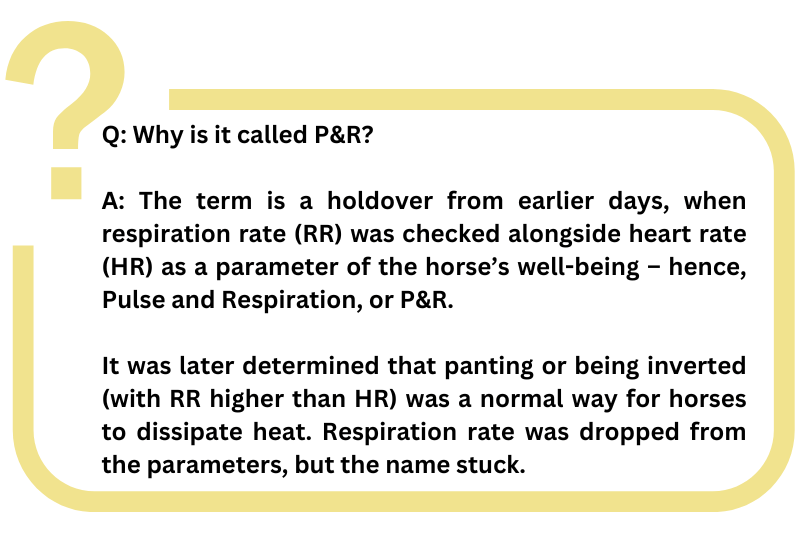
Your experience in P&R may vary dramatically, even between holds at the same ride. That’s because its chaos level depends on how many teams happen to be coming through and how many pulsers are available.
At a busy time or at a big ride, you might need to wait in line to get your horse’s pulse checked. Other times, you might the only one there.
If the pulsers aren’t swamped, they may give you a “courtesy check” to see whether your horse is down. If they’re busy, it’s best to wait to ask for a check until you’re pretty sure your horse is ready before requesting a check.
While the pulser checks your horse, do your best to keep him standing quietly. Positioning him so his left foreleg is slightly forward will give the pulser easy access to place the stethoscope in front of the girth.
Assuming your horse is down, the pulser will take your ride card (if the timers didn’t already) and ensure that your down time and out time are noted before giving it back to you.
Your “down time” is the exact time your horse was confirmed by a pulser to be at or below the established heart rate criteria.
Your “out time” is the time you can leave the hold. It is calculated by adding the mandatory number of hold minutes to your down time. For example, if your horse is down at 10:01 and the hold is 45 minutes long, your out time will be 10:46.
Bear in mind that the volunteers have a tough job. They are trying to communicate with each other over a bustle of people and horses, some of whom are rather tense.
Above all, be kind. Be patient. Calmly repeat your number if needed. Wait your turn. Be cognizant of others and balance their needs with your own.
And what exactly do you need? Just two things:
- A pulser to check your horse’s heart rate and declare him down
- Your ride card back, with your down time and out time written on it
Help Your Horse Pulse Down
Many horses will already be “down” (that is, their heart rates will be down to criteria) upon arrival at the check. However, others may struggle. Some factors that make it harder to pulse down include:
- Inadequate fitness for the pace or distance ridden
- Body type (heavily muscled, stocky, or overweight horses typically have a harder time)
- Hot weather
- Emotional state
- Physical discomfort
If your horse isn’t down, here are some things you can do to help him get there:
- Let him drink, but keep him from thinking about food until he’s down.
- Let him pee. Some people try to train their horses to pee upon a signal, like a whistle.
- Cool him by sponging water over him, focusing on his neck and groin.
- If he’s very hot, removing your saddle may be necessary.
- Remove his bit. Most endurance riders use some kind of bridle that enables them to remove a bit or hackamore while keeping a halter in place.
- Rinse or rub your horse’s face. If histamines in his sweat are making his face itch, he may not be able to relax until this is addressed.
- If he’s obsessing about his buddy, have someone bring the buddy horse over. Although arguably not ideal from a training perspective, this is within the rules and necessary for some horses to relax.
- Ask him to lower his head, using a cue trained ahead of time.
- Remove interference boots and other leg protection if he’s stomping or otherwise acting like they’re bothering him.
- Consider his personality. Some horses can settle down amidst the bustle, but others do better if moved off to the side.
- Calm your own emotions and body. Take a deep breath. Roll your shoulders. Release your anxiety so as not to transfer it to your horse.
- Gentle walking may help a horse’s heart rate recover better than standing still.
- Don’t implement “good ideas” (like kneeling down or tossing buckets of water) if they freak out your horse because he isn’t used to them.
Once your horse’s heart rate is down to criteria, the clock on your hold time will start ticking. Be sure you get your ride card back from the timer and check your out time. You might want to set an alarm on your watch.
Keep your ride card handy, as you’ll need it for vetting next.
Visit the Vet
During the hold, your horse needs to visit the vet. You can do this at any time, though most riders choose to go straight to the vet after pulsing down. This can be advantageous because it’ll get your trot out done before your horse stiffens up from standing still. It will also give you more time to address any small issues identified by the vet.
Vet checks during the ride are essentially the same as your pre-ride vet check, which you can read about in detail in Step-by-Step Guide: The Evening Before. However, there are a few differences:
- In most cases, you’ll do your mid-ride vet checks with tack on. (If the vet wants tack off, usually due to very hot or humid weather, she will have announced this at the pre-ride meeting.)
- If there is a line for the vet, try to grab a handful of hay for your horse to munch while you wait.
- If you are in pain, it’s okay to ask someone to trot your horse for you.
Be sure to check your horse’s scores when you get your card back from the vet. All A’s are ideal, but it’s possible that you will see a B or two.
Reduced gut sounds are fairly common after a long loop, especially if your horse was too excited to eat along the trail. If this is the case, the vet will likely point it out to you and emphasize the importance of ensuring that your horse eats and drinks well during the hold. Assuming he does so, he’ll probably be just fine.
If the vet has concerns about your horse’s metabolic status or soundness, she may ask you to come back for a re-check before leaving the hold. If this happens, the vet will probably keep your ride card for now.
Otherwise, you will get your ride card back and stow it in your saddlebag. You won’t need to return to the vet until you come in from the next loop.
If you see anything unusual happening with your horse during the hold, you can certainly take your horse back for a re-check voluntarily. It’s not a bother! The vet’s top priority is the safety of your horse.
Take Care of Your Horse
As soon as you’re done vetting, turn your attention to caring for your horse. You’ll typically do this either at your trailer (if it’s nearby) or using supplies in your crew bag.
Read about How to Pack a Crew Bag for an Endurance Ride.
Feed and Water
Priority number one is to get your horse eating and drinking. As soon as possible, hold or tie your horse where he can reach a bucket of water and offer him feed.
Most riders give their horses a mash, often of soaked beet pulp. You can mix in some ulcer preventatives like Neigh-Lox and Outlast pellets.
Just like in the morning before the ride, Dr. Susan Garlinghouse advises in Beating the Metabolic Pull against feeding a large meal (more than 4-5 pounds) during the vet check. A couple pounds of mash and some hay, perhaps with a small flake of alfalfa, is generally appropriate.
Horses should typically be eager to eat during the hold. If you find that yours is distracted or otherwise reluctant, try tempting him with grass, carrots, apples, peppermints, alfalfa, pellets, or a neighboring horse’s hay. Horses always seem to think someone else’s meal is tastier than their own!
Often, once you get your horse started eating, he’ll continue and gain enthusiasm. If he has been eating for a while and stops, try offering him some water. He may just need a good drink before continuing to eat.
During long holds (around a hour), some horses will eat well for 20-30 minutes and then take a little nap. This can certainly cause anxiety in a watchful rider, but it isn’t necessarily a problem. Over time, you’ll get to know what is normal for your horse.
If your horse continues to ignore or pick at his feed throughout the hold, do not go back out on the trail! Take him back to the vet for a re-check. It is not unheard-of for horses to get all A’s during their check, only to colic 20 minutes later.
Check and Reset
While your horse eats, check him over for anything that could make him uncomfortable. Pick his hooves or reset his hoof boots, if needed. Maybe brush away sweat and mud from around the edge of his saddle pad, belly, and hind legs.
Refrain from fussing over your horse too much. Do the minimum to provide good care, then leave him alone to eat in peace. Long stretches on the trail can be mentally exhausting for him, so this down time can really help him reset.
Electrolyte
Most riders dose their horses with electrolytes during the hold. Some horses will eat electrolyte powder mixed into their mash. If you need to syringe your horse, its generally advisable to do this shortly before leaving the hold because it may make your horse reluctant to eat.
Never give electrolytes to a dehydrated horse. Make sure his hydration parameters from the vet looked good, and ideally wait until after he’s had a good drink before dosing.
Take Care of Yourself
Once your horse is checked over and eating, take some time to address your own needs.
Address Pain
Is anything hurting? If you’re experiencing pain, do your best address it now. It’ll only get worse on the next loop, and physical discomfort will detract from your ability to support your horse.
Here are a few things you can fix mid-ride if needed:
Skin rubs – If the skin isn’t broken, use a product like Body Glide to prevent further rubbing. You can also try changing clothes or adding a tight, slick layer (like a rash guard) under your usual shirt or breeches.
Heat rash – Rub zinc-oxide cream on the affected areas. Let those areas get some air, if possible, such as by removing your half chaps during the hold.
Joint pain – For knee or ankle pain, try raising or lowering your stirrups one notch. (Stay tuned for longer-term solutions in future articles on this blog.)
Muscle pain – The repetitive motion of riding, especially while trying to hold your excited horse to a reasonable pace over rolling terrain, can leave you achy and stiff.
Just walking around helps, but intentionally stretching entire muscle groups (not just the obviously affected areas) will make a huge difference in how you feel on the next loop, not to mention the next day.
I developed a short routine that I call “Horse Trailer Yoga” to loosen up those muscles between loops. It takes two minutes and can be performed in the aisle of your LQ. You can download the free video below.
Fuel Your Body
You need to eat! Yes, even if you don’t feel like it. Check What to Eat on an Endurance Ride for snack and lunch ideas.
If you do have an appetite, be sure not to eat too much. Trotting on a full stomach is no fun. Personally, I prefer to eat a small quantity of calorie-dense food instead of a large meal.
Continue to hydrate. Again, avoid overfilling your stomach with too much at a time, but do take in water and electrolytes, as both are necessary for your body’s continued production of energy.
Refill and Reset
While you eat, take care of refilling and resetting so everything is ready for the upcoming loop and the next hold:
- Refill your saddle bags with water, snacks (horse and human) and electrolytes (horse and human)
- If it’s warming up, make sure you have a sponge and remove your horse’s rump rug if he was wearing one
- Swap out jacket and sun shirt layers as needed
- Refresh your sunscreen and insect repellant
- Start more beet pulp soaking
- Double-check that your ride card is safely back in your saddle bag
Countdown to Departure
You’ve been watching the time, right? Although there’s no rule preventing you from spending extra time in the hold, it’s best not to unless your horse needs it to recover.
About five minutes before your out time, bridle your horse and tighten his cinch. Head on over to the P&R area, where you can offer him a final drink.
Let the volunteers at the timing table know you’re there, and they’ll tell you when your time is up and you’re free to leave. Verbally confirm that you’re leaving (“Number 34 is out!”) so they can keep track of you for safety purposes.
And, you’re off again!
Be sure you’re following the correct ribbons in the correct direction, and don’t mosey. Both horses and riders tend to feel sluggish after holds. Instead of settling into that mindset, rally your enthusiasm and transfer it to your horse. Trot on out of the hold and enjoy that next loop!
The final post in this series covers the finish and how to wrap up your ride experience on a high note.
Grab the Guide for easy reference in ride camp!
Be sure you’re subscribed to my bi-monthly newsletter to get a heads up on new posts, plus subscriber-only content. It’s like getting an extra two blog posts every month!
You might also like
This post includes affiliate links, and I may earn a small commission (at no extra cost to you) when you purchase through these links. I only recommend products and services I think are helpful and useful. Thanks for helping me offset the cost of maintaining this blog as a free resource!

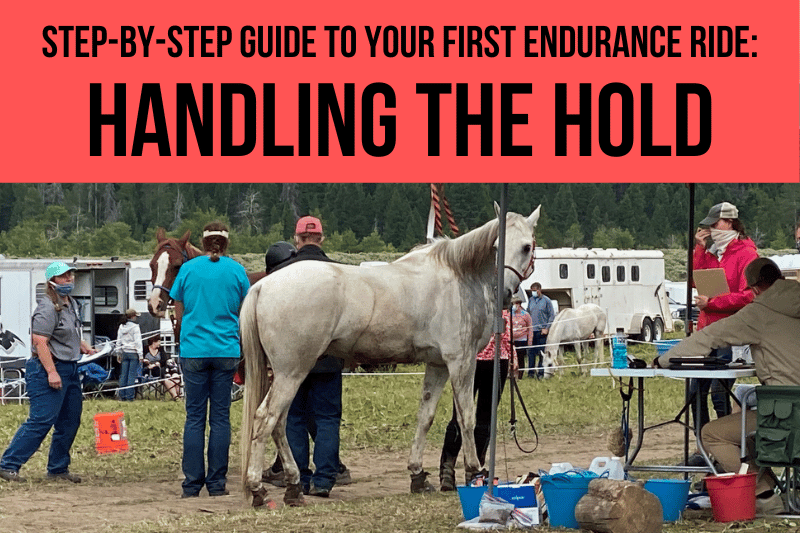

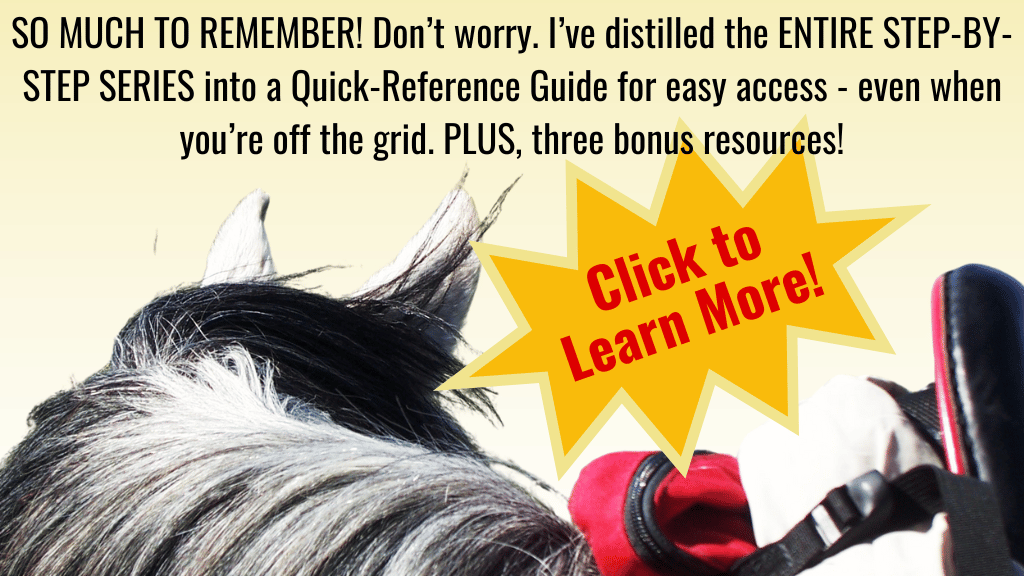
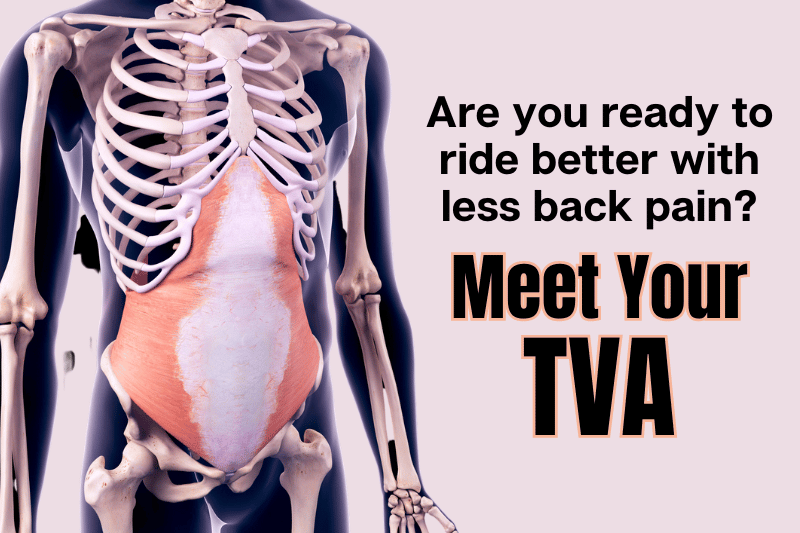
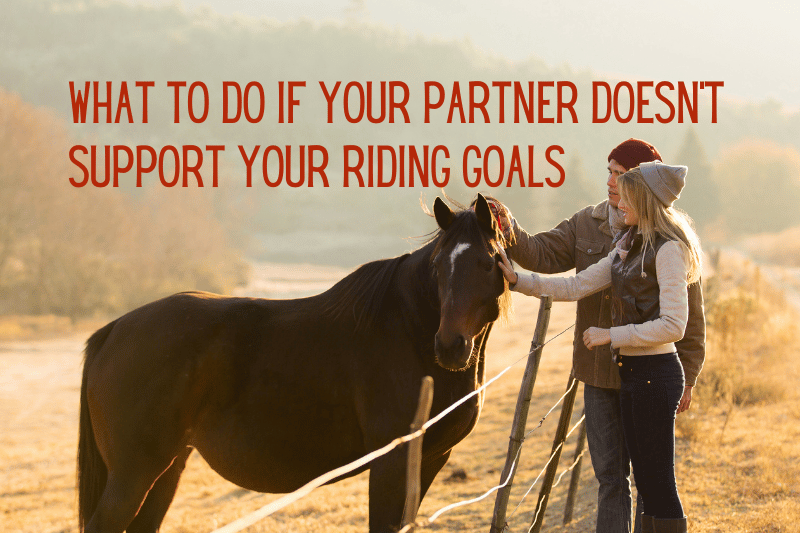
What do you do with your ride card when you’re ready to go back out? Keep it with you, give it to the timers?
Hi! 🙂 The timers will give your card back to you after your horse is pulsed down. You’ll need it for vetting. After that, you’ll stow it in your saddle bag so it is ready to go along with you on your next loop.